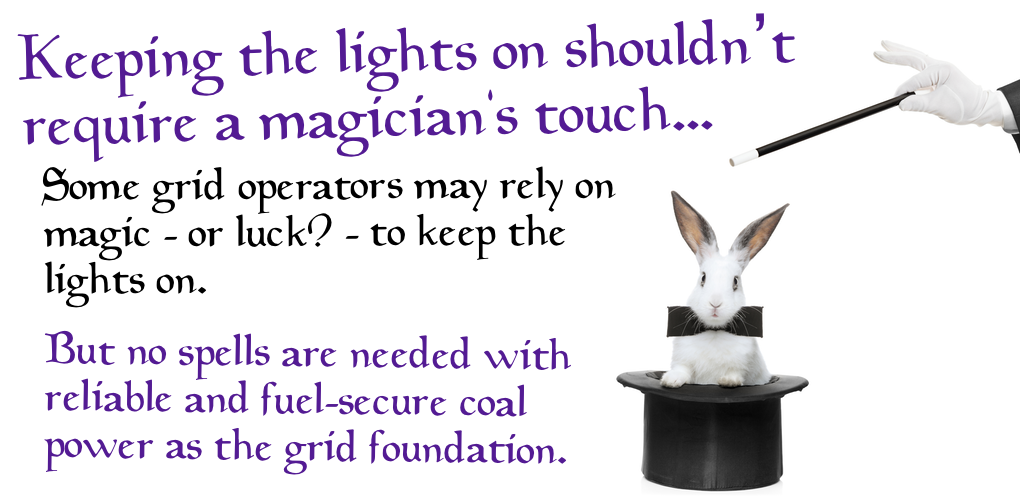
No Way in Hell
The North American Electric Reliability Corporation (NERC) analyzes the reliability of our electricity supply. NERC’s reports and statements are consistently measured, typically packing all the flair and excitement of a buttoned-down white dress shirt. So, it’s with good reason that eyebrows were raised when NERC’s CEO, Jim Robb, recently told the Federal Energy Regulatory Commission that when most engineers look at the Texas grid, they would conclude that “there’s no way in hell they can keep the lights on. And yet they do.”
Peter Behr of E&E News reported that Robb also said that Gordon van Welie, CEO of New England’s grid operator, “constantly finds another rabbit to pull out of his hat to keep the lights on when any of us would look at that situation and say, ‘It’s got to break.'”
While Robb was praising the skill of the Texas and New England grid operators, he – and almost certainly his staff at NERC – were also admitting that there are huge challenges facing grid reliability. And it’s not just the Texas and New England grids. California’s grid, facing the unique challenge of an ever-growing duck curve, is also drawing increased attention from regulators.
At the heart of Robb’s concern – or amazement – is how all three grids and their operators are managing a loss of baseload, dispatchable power and new reliance on intermittent sources of electricity.
While all three grid operators are likely to provide a laundry list of measures they have taken, the key word likely missing from the list is “luck.” It’s unsettling, but what if that’s precisely the secret ingredient that has so far kept things together? What if an extended heatwave or cold snap coincides with reduced wind generation or a pipeline rupture? In other words, what if the luck runs out.
Far from the reliability crisis getting better, it’s, in fact, getting far worse. The challenges, now primarily confined to Texas, New England and California, are about to start popping up in other regional grids as more coal and nuclear capacity closes and a larger share of the nation’s electricity is met by intermittent renewables and an overstretched natural gas pipeline system. State energy policy – namely ever more ambitious renewable portfolio standards – is on a collision course with the limits of engineering.
Not Enough Pipelines, Not Good Enough Batteries
As The Wall Street Journal reported this week, despite surging U.S. natural gas production, up 44% from a decade earlier, the pipeline infrastructure to move that gas to where it’s needed hasn’t kept up. “Pipelines aren’t in the right places, and when they are, they’re usually decades old and often too small. The result, despite natural-gas prices that look low on commodities exchanges, is energy feast and famine.”
While keeping up with surging demand for gas is hard enough, environmentalists are attacking natural gas pipelines to halt further reliance on a fuel they see as a problem. As the Journal explains, “Proponents of reducing the use of fossil fuels have had little luck limiting drilling in energy-rich regions. Instead, they’ve turned to fighting pipeline projects on environmental grounds in regions like New York and the Pacific Northwest, where they have a more sympathetic ear.”
The result is inadequate pipeline capacity, leading to price spikes and fuel shortages – and even an announcement from a utility in New York that it will no longer take any new gas customers for fear it can’t meet demand.
And while new pipelines keep hitting roadblocks, alternative-fuel power plants, namely coal plants, that provide balance to our power sector, continue to be forced into early retirement by electricity markets that seem incapable of recognizing and accounting for the building reliability crisis.
Greater reliance on natural gas to take up the slack of the loss of the coal fleet is clearly a deeply flawed plan. Renewable energy hawks, determined to race ahead to an all-renewable grid, have an even worse one. While quick-ramping natural gas plants are currently being used to manage the swings in generation that come from solar and wind power, renewable boosters are counting on grid-scale energy storage to take their place. Batteries are their proposed solution to providing the essential backup required to maintain grid reliability, regardless of the weather. Except batteries aren’t up to the task.
NERC’s Jim Robb spared no punches on the issue, recently telling reporters today’s utility-scale battery technology won’t cut it. It’s a sentiment echoed by former U.S. Energy Secretary Ernest Moniz who told Bloomberg News that short-term energy storage (batteries) can only do so much in integrating renewable power onto the grid. “It’s not going to handle a day, a week, a month, a season,” he said. To put a finer point on it, Wood Mackenzie just calculated that to move the grid to all renewable power would require 900 GW of energy storage. There is currently only 5.5 GW of battery storage in operation or under construction in the entire world.
If natural gas is proving no panacea and grid-scale energy storage is best suited for a few hours of backup, then it would seem prudent to maintain coal generation, the fuel-secure, baseload foundation of the grid. The path we are charging down is leaving regulators scratching their heads wondering just how regional grids haven’t collapsed. Eventually, our luck is going to run out. There will be no more rabbits to pull out of hats. Are we ready to reckon with the consequences?
- On July 10, 2019
